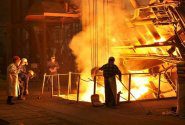Yesterday, 13 contracts for the maintenance and increase of oil production were signed between the two offshore oil companies of Iran and the National Oilfields of the South as an employer.
With the implementation of this contract, the value of which is more than one billion and 527 million Euros and 14 Iranian companies are present in its implementation, about 185 thousand barrels will be added to the country’s oil production capacity.
Thus, it seems that in a situation where the daily production of Iranian crude oil has decreased due to US sanctions, the Ministry of Oil is determined to prevent the reduction of the country’s oil production capacity. Naturally, if an oil well is reduced in production, production will decline over time. This drop in production can even lead to a well being taken out of the production cycle, which, if it happens, will take a long time to recover. Therefore, during the embargo period, it is not only the reduction of sales and production that is important, but also the impact that the decline in production will have on the lives of oil wells, so the implementation of production maintenance programs will be of great importance. In fact, if such plans are not implemented, the lifting of sanctions will not allow a rapid return to pre-sanctions production capacity.
*** Plan to maintain and increase oil production
During the Borjam era, Iran managed to return production to pre-sanctions levels in a short period of time. Considering the issue of maintaining production is especially important because the International Energy Agency forecasts that as a result of the pressure of unilateral Western sanctions, Iran’s ranking in the 2040 perspective will fall to seventh place among oil producers. If this prediction comes true, it will be far-fetched to achieve the production of 5 million and 500 thousand barrels, which is emphasized in the development laws of the country to reach 1404. Increasing the country’s oil production capacity means increasing Iran’s economic and political power, a point that the Minister of Oil also mentioned yesterday, and it seems that by signing this agreement, at least some steps will be taken towards it.
At the signing ceremony of these 13 oil contracts, Bijan Zanganeh stressed the need to build capacity to produce oil in the face of sanctions and said: “A country’s power in the oil market is not in its reservoirs, but in production capacity.” Oil is defined in the form of 33 work packages in the scope of activities of three companies affiliated to the National Iranian Oil Company (National Company of Southern Oilfields, Offshore Oil Company of Iran and Central Iranian Oil Company) in the geographical area of seven provinces. The financial resources required for this project are defined by relying on the revenue generated by the increase in oil production in work packages and through the issuance of bonds in the capital market.
*** Increasing the recycling rate guarantees the creation of wealth
“In the global oil industry, there is a consensus that the main pillar of all technical activities upstream of oil is to increase the recovery factor or the coefficient of extraction of oil from oil fields in accordance with the nature and conditions of each reservoir.” This is part of Zanganeh’s speech yesterday. In another part of his speech, he said: “If we do not say that increasing recycling is more important than the issue of common fields, its level is significant, because with a one percent increase in recycling rate, more than 7 billion barrels of oil will be added without new exploration in the country.” Billion dollars of wealth in the country.
*** New life to dozens of oil rigs
“Our intention is to use all methods in parallel to develop the oil fields, and not to limit ourselves to any of the methods,” Zanganeh said. “If we did not have these plans, we would now be able to maintain and increase oil production.” Production stopped in the fields being exploited. According to him, about 130 to 140 wells will be drilled in this project, and another 60 to 70 wells will be repaired, which means working for tens of rigs, with 300 to 400 people working on each rig.
این مطلب بدون برچسب می باشد.










ثبت دیدگاه